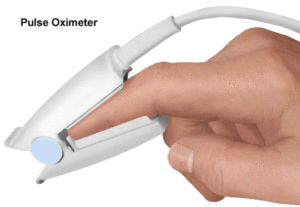It essentially consists of a probe with two light emitting diodes and a photodetector and a microprocessor. Pulse oximetry is a standard non-invasive method for monitoring of arterial blood O2 saturation at the level of arterioles using Pulse oximeter. It is a simple, continuous measurement of oxygen saturation, accurate, dependable, convenient and rapid method using types of sensors. Pulse normal range, Types of the Pulse Oximeter and understanding the waveform
Percentage of hemoglobin, the protein in blood that carries oxygen.
Acceptable pulse normal ranges for patients 95% to 99 % of saturation.
Pulse normal range 95% to 99 % of saturation acceptable and in diseased patients 90 %
For a patient breathing room air at or near sea level, an estimate of arterial pO2 can be made from the blood-oxygen monitor “saturation of peripheral oxygen” (SpO2) reading. calculated arterial hemoglobin oxygen saturation value and display along with heart rate (HR) and arterial blood pressure
Indication-Pulse oximeter
The main purpose of the pulse Oximetry is to monitor the oxygenation. It provides the warning of the hypoxemia.
It’s helpful in detecting the desaturation problems in the condition of
- Fat embolism.
- Aspiration pneumonitis.

- Malignant hyperpyrexia.
- Thyroid crisis.
- Breathing system malfunction.
- Emergency condition.
- Preoperative and postoperative.
- Useful in oxygen administration.
Working Principle of Pulse oximetry
Its works under the principles of the spectrophotometry and optical plethysmography
A microprocessor analyzes the signal.
One LED red 660 nm wavelength and infrared 940 nm wavelength. A light emitting diode that measures the absorption of a specific wavelength of light relative to the ratio of oxyhemoglobin and reduced hemoglobin by the sensor placed on the patient site.
Oxygenated hemoglobin permits more infrared light and passes more red light to pass. Deoxygenated hemoglobin permits more infrared light to tissues and takes more red light.
Pulse oximeter Common sites of the sensor
The most common site of a sensor device is placed on the thin part of the patient’s body, usually a
In the case of an infant,
1.across a foot(palm)
- wrist, forefoot.
Types of the Pulse Oximeter Devices
Types of the Pulse Oximeter Finger Oximeter
For spot checking by clinicians, patients, caregivers, and consumers. Used for personal health and wellness, home care, hospital, and clinics. Used in transporting of patients, works with DC battery
Handhelds pulse oximeters with Sensors
For spot checks or continuous monitoring; ideal for hospital, ambulatory, home or EMS.
Tabletops pulse oximeters with Sensors
For spot checks or continuous monitoring; ideal for hospitals, medical facilities, homecare, and subacute settings. used in operation theatre, intensive care units, emergency unit, postoperative area, etc.
Wrist-worn pulse oximeters with Sensors
Wireless, ideal for daily activity monitoring.
Pulse Oximetry Sensors type
Neonate, pediatric, adult; reusable and single-patient-use disposable varieties for Nonin handheld, tabletop, and wrist-worn pulse oximeter. Sensors type may vary in age group
TIPS TO GET MOST ACCURATE IN CLINICAL FIELDS
- Vigorous rubbing of the fingertip may improve the circulation temporarily.
- Excessive movement and Malpositioning of the probe may give a false result, it is better to tape or wrap the sensor with the patients’ site of measurement.
- Pressure on the sensor may cause inaccuracy.
- Protect the sensor from the bright sunlight, radiant warmers, fluorescent bulbs can contaminate light emitting diode signals
- Nail polish can alter the spectra of emitted light. In site nail polish is to be removed or avoid that site because, it measures the changing absorbance at each of the wavelengths, allowing it to determine the absorbances due to the pulsing arterial blood.
- To avoid injuries on the sites frequent inspection of probes sites
The disadvantage of pulse oximetry.
- Using electrocautery, hypothermia, hypotension, low hematocrit, pigmented skin, poor perfusion, vasoconstriction may cause the failure of measurement may cause a high risk to patients.
- It only gives the patients oxygenation, it does not give any indication of patient ability to eliminate the carbon dioxide.
- Inaccurate readings may lead to carbon dioxide poisoning presence of dyes and methemoglobinemia.
- Vasodilatation and pooling of venous blood in the head due to compromised venous return to the heart, as occurs with congenital cyanotic heart disease patients.
- In patients in the Trendelenburg position, can cause a combination of arterial and venous pulsations in the forehead region and lead to spurious SpO2 (Saturation of peripheral oxygen) results.
Alarm in spO2
Alarm limits are set for a low saturation value. The set alarm will be higher and low pulse rates values on the console.